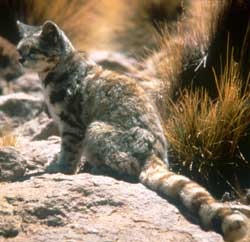Rare Andean Cat No Longer Exclusive to the Andes

The finding represents a range extension for the Andean cat, which normally occurs at altitudes above 3,000 meters (approximately 9,800 feet). The new survey presents evidence of the cats occurring at elevations as low as 650 meters (approximately 2,100 feet) on the Patagonian steppe. The species is listed as “Endangered” on the World Conservation Union’s Red List and may number only 2,500 individuals throughout its entire range.
The study appears in the recent edition of CATNews. The authors include: Andres Novaro and Lorena Rivas of the Wildlife Conservation Society and CONICET, Argentina; Susan Walker of the Wildlife Conservation Society; Rocio Palacios of Alianza Gato Andino; Sebastian di Martino of Department of Protected Areas of the Province of Neuquén; Martin Monteverde of Centro de Ecología Aplicada del Neuquén; Sebastian Canadell of Universidad Nacional de Cordoba; and Daniel Cossios of Université de Montréal.
“These confirmed records show the lowest elevations ever reported for the Andean cat,” said WCS conservationist Andres Novaro, lead author of the study. “According to genetic studies underway led by Daniel Cossios, this new population appears to represent an evolutionary lineage distinct from the highland population.”
Prompted by a lone photograph of two Andean cats in the foothills of central Argentina, the research team surveyed approximately 31,000 square kilometers (approximately 12,000 square miles) of Argentina’s Mendoza and Neuquén provinces in 2007-2009. The team collected samples from several locations that included scat, skulls, and skin, all of which were confirmed with DNA analysis. In addition, the researchers conducted surveys with inhabitants of the region. The conservationists also found evidence of three other small cat species: Geoffroy’s cat, pampas cat, and jaguarundi.
The Andean cat’s range extension coincides with the known distribution of the mountain vizcacha, a rabbit-like rodent that inhabits both the Andes Mountains and Patagonian steppe and is the Andean cat’s primary prey.
“Discovering a new population of Andean cats is an important finding for this elusive and rare species,” said Mariana Varese, Acting Director of WCS’s Latin America and Caribbean Program. “Determining the range of the Andean cat in the Patagonian steppe will provide conservationists with a foundation for later conservation plans.”
Threats to the newly discovered population of Andean cat include goat herders who assume the felines are preying on their livestock, oil exploration activities that destroy habitat, and new roads that open up formerly inaccessible areas to poachers.
Critical support for this study was provided by Panthera, the Rufford Small Grants Foundation, Wildlife Conservation Network, and the Whitley Fund for Nature. WCS is grateful to the following for their partnership: the Department of Renewable Natural Resources of Mendoza and the Department of Protected Areas of Neuquén provinces.
WCS’s programs and activities in the region are generously supported by the Butler Conservation Fund and the Liz Claiborne and Art Ortenberg Foundation.
Media Contact
More Information:
http://www.wcs.orgAll latest news from the category: Ecology, The Environment and Conservation
This complex theme deals primarily with interactions between organisms and the environmental factors that impact them, but to a greater extent between individual inanimate environmental factors.
innovations-report offers informative reports and articles on topics such as climate protection, landscape conservation, ecological systems, wildlife and nature parks and ecosystem efficiency and balance.
Newest articles

Superradiant atoms could push the boundaries of how precisely time can be measured
Superradiant atoms can help us measure time more precisely than ever. In a new study, researchers from the University of Copenhagen present a new method for measuring the time interval,…

Ion thermoelectric conversion devices for near room temperature
The electrode sheet of the thermoelectric device consists of ionic hydrogel, which is sandwiched between the electrodes to form, and the Prussian blue on the electrode undergoes a redox reaction…

Zap Energy achieves 37-million-degree temperatures in a compact device
New publication reports record electron temperatures for a small-scale, sheared-flow-stabilized Z-pinch fusion device. In the nine decades since humans first produced fusion reactions, only a few fusion technologies have demonstrated…





















